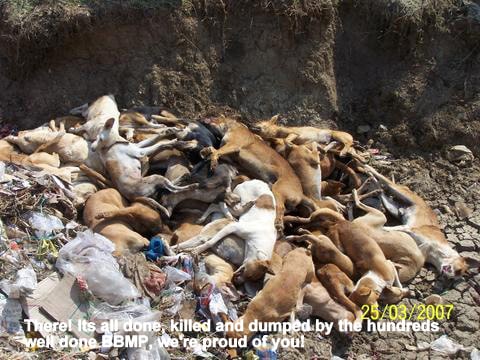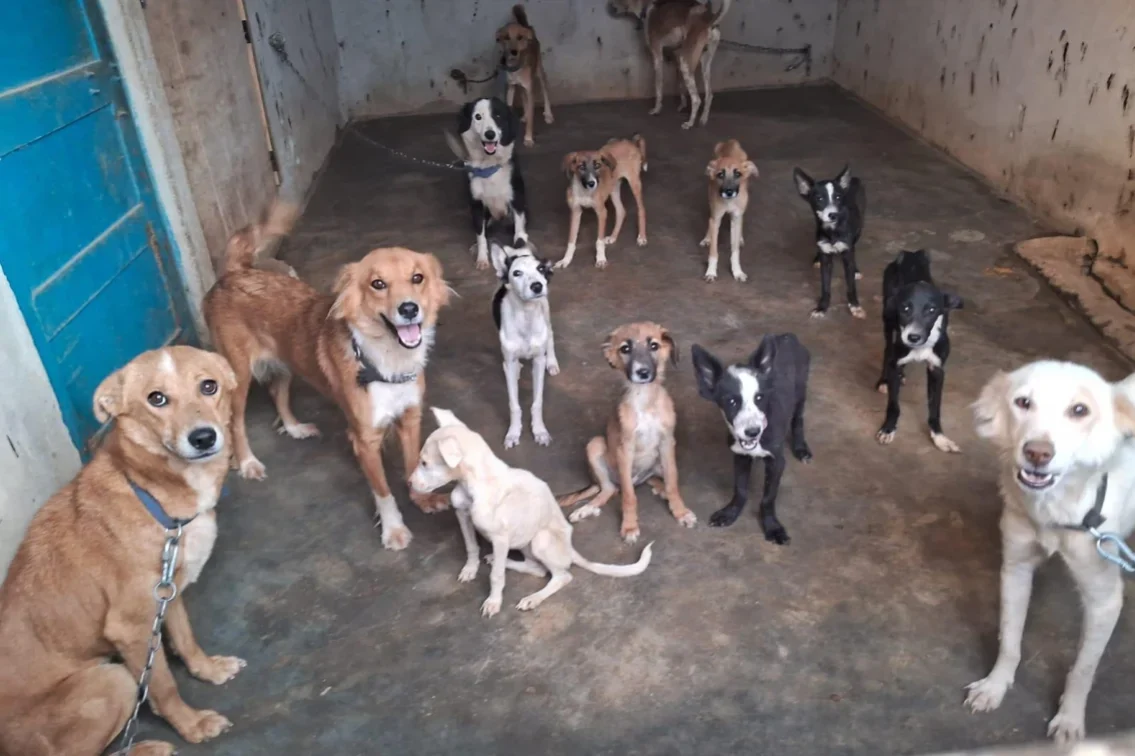This is an analysis occasioned by an article in the Bangalore Mirror of 19th October, 2012, titled, “Police have power to kill strays”, which claims that ‘Karnataka Police Act not only gives the cops authority to kill dogs but also says they have to do it regularly’.

The “gems” contained in this article, with a reference to a legal provision and a smattering of views and assertions, are a classic example of IRRESPONSIBLE & MOTIVATED REPORTING, obviously resorted to in order to inflame and engineer a situation that will be lawless, and contrary to Central Law, and to a stay order passed by the Hon’ble Supreme Court of India.
In fact, during the course of INTERPRETATION OF STATUTES, when confronted with Central and State law provisions on the same subject that are disparate and contrary, and say two different things, an attempt to ‘harmonize’ the disparate provisions has to be made, in order to give effect to both without incongruity, if the same is possible. IF THE SAME IS NOT POSSIBLE, CENTRAL LAW PROVISIONS USUALLY PREVAIL (In this case, the ‘same subject’ that the Central Law, i.e. the Prevention of Cruelty to Animals Act, 1960, and the Animal Birth Control (Dogs) Rules, 2001, the State Law, i.e. the Karnataka Police Act, 1963, purport to deal with, are the circumstances in which destruction of stray dogs can be ordered. ) Moreover, in any case, the Hon’ble Supreme Court of India is already deliberating upon the issue of street dogs, and control of their population, control of dog related nuisance, and eradication of the threat of rabies; and had passed a stay order against culling of even the dogs claimed to be a nuisance, in the matter titled ‘AWBI Vs PEST and Anr’, being S.L.P. (C) No. 691 of 2009, on 23rd January, 2009. The stay order passed by the Supreme Court is still in operation.
It is in this backdrop that the assertions contained in the Bangalore Mirror article of 19th october, 2012, are being examined below:
I.
The article claims that ‘Last week, the HC said that the BBMP can act according to the Karnataka Municipal Corporations Act (KMC) for controlling strays but in a humane manner’! This is clearly wishful thinking by the reporter, and a figment of his imagination. It is obviously incorrect.
The High Court of Karnataka is aware that the Apex Court is deliberating upon the issue of street dogs, and control of their population, control of dog related nuisance, and eradication of the threat of rabies in a bunch of 5 petitions pending before it, including petitions by the Animal Welfare Board of India and the Ministry of Environment and Forests, Union of India. Two very important QUESTIONS OF LAW that the AWBI, MOEF, and others have posed before the Supreme Court in those petitions are:
“A. Whether a law made by the Legislature of a State can be allowed to override a law enacted by Parliament, and interfere with the implementation of the scheme sought to be promoted, and undermine the objective sought to be achieved by the law enacted by Parliament?
B. Whether an interpretation that allows conflict between a law made by the Legislature of a State and a law enacted by Parliament, is to be preferred over an interpretation that provides for reading down the State Legislation to give effect to the Central Legislation that occupies the field?”
See also the stay order against culling of even the dogs claimed to be a nuisance, that was passed by the Supreme Court in the matter titled ‘AWBI Vs PEST and Anr’, being S.L.P. (C) No. 691 of 2009, on 23rd January, 2009, i.e. the date on which the petition was first listed. Therefore, it is highly unlikely that the High Court will have said what the reporter is trying to attribute to them.
II.
The article also claims that ‘While the KMC Act provides for civic bodies to destroy at any time only rabid dogs, the Karnataka Police Act (KPC) says that the police commissioner and superintendent can from time to time issue a public notice and destroy stray dogs.’ The first part of this assertion is again, clearly incorrect. Section 345 of The Karnataka Municipal Corporation Act, 1976 which deals with Destruction of stray pigs and dogs, reads as follows: –
345. Destruction of stray pigs and dogs.- If any dogs or pigs are found straying, the same may be summarily destroyed by any person authorised in that behalf in writing by the Commissioner.
A reading of the provision will make it apparent that the power to destroy stray dogs, and not just rabid stray dogs, is equally available under the other state law in question, i.e. the Karnataka Municipal Corporation Act, but cannot be resorted to because of the Supreme Court stay order against culling of stray dogs.
III.
The article also attributes the following statement to one Advocate A V Amarnathan: ‘When read as a whole, Chapter 4 of KPA talks about the power of police to control all kinds of animals found in public places. Section 43 is, however, specifies that police have to control stray dogs. Since the AWBI is strongly trying to implement the Animal Birth Control (ABC) rules, the BBMP or any civic body has no powers to actually kill dogs. They only recommend sterilization and immunization to control the population. The KPA not only gives police the powers to kill dog but also says it is to be done regularly.’ It also quotes one Advocate K V Dhananjay as having said: ‘….. As far as the KPA is concerned, stray dogs do not have any legal position. Stray dogs are not emancipated. Any stray is deemed to be a nuisance by law. The police being responsible for destroying not just dogs but any unclaimed animals is well established law. Civic agencies are given the powers to control all such animals but police have the power to destroy them.’
These learned counsel, (if there are actually counsel by this name), need again to look at the scheme of Indian law, and the Indian Constitution, and Article 51 A (g) of the Constitution, and acquaint themselves afresh with this principle of interpretation : That during the course of INTERPRETATION OF STATUTES, when confronted with Central and State law provisions on the same subject that are disparate and contrary, and say two different things, an attempt to ‘harmonize’ the disparate provisions has to be made in order to give effect to both, without incongruity, if the same is possible. IF THE SAME IS NOT POSSIBLE, CENTRAL LAW PROVISIONS USUALLY PREVAIL.
IV.
It is, of course, not incorrect that Section 43 of the Karnataka Police Act, 1963, confers the power on the police to resort to destruction of stray dogs (in the circumstances and in the manner set out in the provision). What is incorrect is the underlying assumption that the Karnataka Police Act, 1963, is a ‘stand-alone’ enactment, and Section 43 of the said Act a ‘stand-alone’ provision, that can operate notwithstanding disparate and contrary provisions in Central Law, and notwithstanding Article 51 A (g) of the Constitution of India.
V.
A Central Law, i.e. the Prevention of Cruelty to Animals Act, 1960, mandates that dogs shall not be killed/euthanized, except in the circumstances prescribed; and the circumstances in which dogs can be euthanized, are prescribed in Rule 9 of the Animal Birth Control (Dogs) Rules, which read as follows:
9. Euthanasia of Street Dogs : Incurably ill and mortally wounded dogs as diagnosed by a qualified veterinarian appointed by the committee shall be euthanised during specified hours in a humane manner by administering sodium pentathol for adult dogs and Thiopental Introperitoneal for puppies by a qualified veterinarian or euthanised in any other humane manner approved by Animal Welfare Board of India. No dog shall be euthanised in the presence of another dog. The person responsible for euthanizing shall make sure that the animal is dead, before disposal.
Section 43 of the State Law, i.e. the Karntaka Police Act, reads as follows:-
43. Destruction of stray dogs—
(1) The Commissioner and the Superintendent in areas under their respective charges may, from time to time by public notice, and after consultation with the Health Officer of the area concerned or other prescribed officer of the Department of Public Health, proclaim that any stray dogs found during such period as may be specified in the said notice, wandering in the streets or in any public place may be destroyed, and any dog so found within such period may be destroyed accordingly.
(2) The authority empowered under sub-section (1) may, by public notice, require that every dog, while in any street or public place and not led by some person, shall be muzzled in such a manner as effectually to prevent it from biting, while not obstructing its breathing or drinking and the Police may, so long as such notice remains in force, destroy, or take possession of and detain, any dog found loose without muzzle in any street or place beyond the premises of the owner thereof:
Provided that any dog so found wearing a collar on which an apparently genuine name and address of an owner is inscribed, shall not, unless it is rabid, be forthwith destroyed, but information of the detention thereof shall forthwith be sent by post or otherwise to such owner.
(3) Any dog which has been detained under sub-section (2) for a period of three clear days without the owner providing a muzzle and paying all expenses connected with such detention, may be destroyed or sold with the sanction and under the orders of the competent authority.
(4) The proceeds of the sale of any dog under sub-section (3) shall be applied, as far as may be, in discharge of the expenses incurred in connection with its detention, and the balance, if any, shall form part of the Consolidated Fund of the State.
(5) Any expenses incurred in connection with the destruction or detention of any dog under this section shall, subject to the provisions of sub-section (4), be recoverable from the owner thereof upon a warrant issued by the competent authority as if it were a warrant issued under section 386 of the Code of Criminal Procedure, 1898.
Since the Central and State law provisions on the same subject, i.e. the circumstances in which destruction of stray dogs can be ordered, are disparate and contrary, and say two different things, an attempt to ‘harmonize’ the disparate provisions will have to be made, in order to give effect to both without incongruity, if the same is possible. IF THE SAME IS NOT POSSIBLE, THE CENTRAL LAW PROVISIONS WILL PREVAIL.
In any case, this question of law, i.e. whether the Central or the disparate State laws will prevail in the context of dealing with street dogs and street dog related issues, is already before the Supreme Court in the batch of 5 petitions pending before it, including petitions filed by the Animal Welfare Board of India, and the Ministry of Environment and Forests, Union of India.
The Supreme Court has stayed the culling of dogs through resort to state law provisions ; and therefore the Karnataka Police Act provisions cannot be given effect to, either.
VI.
What is interesting, and may be noted, is that the same, or provisions similar to Section 43 of the Karnataka Police Act, 1963, are also contained in Section 102 of the Calcutta Police Act, 1866 and Section 29 of the Madras Police Act, 1888, and Section 44 of the Bombay Police Act, 1951; and some other State police laws as well. The same are NOT, however, being given effect to.
VII.
What is also interesting, is this:
(i) The Animal Birth Control (Dogs) Rules, 2001, define ‘local authority’ as follows:
(e) “local authority” means a municipal committee, district board or other authority for the time being invested by law with the control and administration of any matters within a specified local area;
Hence, ‘any authority for the time being invested by law with the control and administration of any matters within a specified local area’, is covered within the definition of ‘local authority’.
It can be argued that this includes the police, especially since the Preamble of the Karnataka Police Act, and other police laws, provides specifically that the police are invested with ‘the maintenance of public order’.
(ii) This argument also finds favour if Sub-Rule (2) of Rule 6 of the Animal Birth Control (Dogs) Rules, 2001, dealing with Obligations of the local authority, is read carefully. The same is as follows:
6. Obligations of the local authority:
……..
(2) If the Municipal Corporation or the local authority thinks it expedient to control street dog population, it shall be incumbent upon them to sterilize and immunize street Dogs with the participation of animal welfare organizations, private individuals and the local authority.
Both terms, i.e. the ‘Municipal Corporation’ and the ‘local authority’, are referred to in sub – rule (2) of Rule 6. Hence, the term, ‘local authority’ is obviously meant to be larger than the term ‘Municipal Corporation’; and it is obligatory for both, the Municipal Corporation, and the local authority, to control street dog population through sterilization.
It can therefore be argued that vide Sub-Rule (2) of Rule 6 of the Animal Birth Control (Dogs) Rules, 2001, the local police, which seems equally to be covered within the definition of the term, ‘local authority’, is obliged as well to control street dog population, dog related nuisance, and the threat of rabies, through sterilization and immunization.
MOREOVER, IN ANY CASE, THE PROVISIONS OF THE CENTRAL LAW, I.E. THE ANIMAL BIRTH CONTROL (DOGS) RULES, 2001, ENACTED LATER IN POINT OF TIME THAN THE DISPARATE PROVISIONS OF THE STATE LAW, I.E. THE KARNATAKA POLICE ACT, 1963, WILL PREVAIL OVER THE DISPARATE AND CONTRARY PROVISIONS OF STATE LAW WITH RESPECT TO THE DESTRUCTION OF STRAY DOGS.












